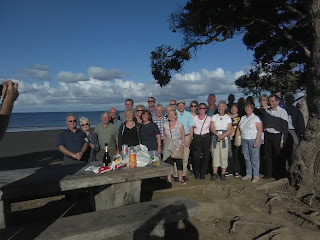Rocky Mountain Rail - Banff 18th July
Banff, Alberta
Four districts of the Northwest Territories formed the provinces of Alberta and Saskatchewan in 1905: Athabasca, Assiniboia, Alberta and Saskatchewan.
Alberta was named after Princess Louise Caroline Alberta, fourth daughter of Queen Victoria. It was proclaimed a Province on September 1, 1905.
The First Nations settled the plains about 8,000 years ago. They sustained themselves by hunting the buffalo. Evidence of their activities can still be seen at Head-Smashed-In Buffalo Jump, which is now a World Heritage Site in southern Alberta. Later, these people — who included the Blackfoot, Blood, and Peigan — tamed horses and hunted buffalo with rifles they obtained from European explorers.
Another group of First Nations, who included the Woodland Cree and Chipewyan tribes, settled the woodland areas of central Alberta. These people hunted caribou, moose and fished the lakes and rivers. They used bark canoes to travel up and down streams in the area.
During the 19th Century, European fur traders married Native women. The result was the creation of a new people unique to Canada's plains. The children of these marriages are called Métis (meaning "mixed"), and they followed a different way of life that was similar to that of the First Nations' lives.
The first European to reach Alberta was the fur trader Anthony Henday, who explored the vicinity of present-day Red Deer and Edmonton in 1754-55. He spent the winter with a group of Blackfoot, with whom he traded and went buffalo hunting.
The fur trade changed the lives of the First Nations. Their somewhat nomadic lifestyle became focused on gathering, transporting and trading furs with European explorers and settlers. In return for their furs, they received guns, blankets and metal goods.
The trade also led to greater knowledge of the geography of Alberta, especially through the work of David Thompson. In the 1790s and early 1800s, Thompson drew the first good maps of the Alberta region as he explored and surveyed for the North-West Company (NWC).
In 1821, the NWC merged with the Hudson's Bay Company (HBC), and the HBC took control of the fur trade across the whole Northwest. The company tried to keep settlers out of the area, but it allowed missionaries to move in.
Alberta's first missionary was Robert Rundle, a Methodist, who arrived at Fort Edmonton in 1840.
The first Roman Catholic missionary was Jean-Baptiste Thibault, who arrived at Lac Sainte Anne in 1842. Some of Alberta's future towns were built at mission sites. For example, Father Albert Lacombe's mission, which is now a historical site, became the city of St. Albert.
In 1870, the Hudson's Bay Company turned over control of the entire Northwest to Canada. In 1872, the region was opened for settlement. To support its claim to the Northwest and to keep law and order in the region, the Canadian government formed the North-West Mounted Police in 1873.
The Mounties established their first post in Alberta in 1874 at Fort Macleod. One of their first tasks was to control the whisky trade.
A major event in Alberta history was the arrival of the railway in 1883. The railway made the Canadian settlement of the West possible. In 1881 there were about 1,000 non-Native settlers in Alberta. Ten years later that number had grown to 17,500.
The most successful early settlers were the ranchers, who found Alberta's foothills to be ideal ranching country. Most of Alberta's ranchers were English settlers, but the cowboys — such as John Ware, who in 1876 brought the first cattle into the province — were American.
Farming the prairie proved more difficult. Most newcomers preferred to settle in the United States West, but by the 1890s, most of the American land was taken. In 1897, Canada's minister of the interior, Clifford Sifton, began a massive advertising campaign in Europe to encourage people to come to the Canadian West.
Alberta was proclaimed a province in 1905 and Edmonton became the capital city.
While most of the early settlers came from Ontario, Britain or the United States, many of the people who came as a result of Sifton's campaign were of German, Ukrainian, and Romanian descent, giving Alberta the diverse population that it has today. The result of Sifton's campaign was spectacular. Alberta's population grew to 73,000 in 1901; to 374,000 in 1911; and to 584,000 in 1921!
When Alberta became a province in 1905, it was not given control of its own resources — creating a dispute with the federal government. Alberta was given control 25 years later.
Alberta suffered severely during the Great Depression of the early 1930s. Droughts, grasshopper plagues, and soil erosion drove many farmers from their land. Even harder to bear was the falling price of wheat. Many farmers went bankrupt and lost their land altogether.
Alberta's destiny was changed forever in 1947, when a major oil discovery was made at Leduc, near Edmonton. As more and more oil and gas discoveries were made, a share of the oil money flowed to the provincial government.
Jobs were created in the petrochemical industry, as well as in construction, surveying, and transportation. Edmonton and Calgary emerged as prosperous cities of business and finance, surpassing their rural neighbours.
After World War II, immigrants continued to come to Alberta from different parts of the world, including Asia and the Caribbean.
While Alberta's economy has continued to expand in many areas, oil still plays a large role in its prosperity. When the price of oil is high, Alberta prospers. When it drops, as it did in the mid-1980s, times may be difficult. In the 1990s, improved oil prices and the growth of new industries helped make Alberta's economy one of the strongest in Canada.
Alberta is now a vibrant, prosperous province, with a high quality of life. Alberta has been host to many world-class events, international sporting competitions, and unique festivals such as the 1988 Winter Olympics in Calgary and the Big Valley Jamboree.


Comments
Post a Comment